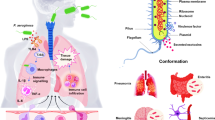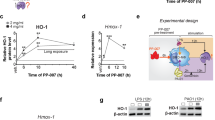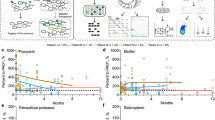Abstract
Pseudomonas aeruginosa is a Gram-negative pathogen that causes severe infections in immunocompromised individuals and individuals with cystic fibrosis or chronic obstructive pulmonary disease (COPD). Here we show that kinase suppressor of Ras-1 (Ksr1)-deficient mice are highly susceptible to pulmonary P. aeruginosa infection accompanied by uncontrolled pulmonary cytokine release, sepsis and death, whereas wild-type mice clear the infection. Ksr1 recruits and assembles inducible nitric oxide (NO) synthase (iNOS) and heat shock protein-90 (Hsp90) to enhance iNOS activity and to release NO upon infection. Ksr1 deficiency prevents lung alveolar macrophages and neutrophils from activating iNOS, producing NO and killing bacteria. Restoring NO production restores the bactericidal capability of Ksr1-deficient lung alveolar macrophages and neutrophils and rescues Ksr1-deficient mice from P. aeruginosa infection. Our findings suggest that Ksr1 functions as a previously unknown scaffold that enhances iNOS activity and is therefore crucial for the pulmonary response to P. aeruginosa infections.
This is a preview of subscription content, access via your institution
Access options
Subscribe to this journal
Receive 12 print issues and online access
$259.00 per year
only $21.58 per issue
Buy this article
- Purchase on SpringerLink
- Instant access to full article PDF
Prices may be subject to local taxes which are calculated during checkout






Similar content being viewed by others
References
Currie, A.J., Speert, D.P. & Davidson, D.J. Pseudomonas aeruginosa: role in the pathogenesis of the CF lung lesion. Semin. Respir. Crit. Care Med. 24, 671–680 (2003).
Rao, S. & Grigg, J. New insights into pulmonary inflammation in cystic fibrosis. Arch. Dis. Child. 91, 786–788 (2006).
Poch, D.S. & Ost, D.E. What are the important risk factors for healthcare-associated pneumonia? Semin. Respir. Crit. Care Med. 30, 26–35 (2009).
American Thoracic Society & Infectious Diseases Society of America. Guidelines for the management of adults with hospital-acquired, ventilator-associated and healthcare-associated pneumonia. Am. J. Respir. Crit. Care Med. 171, 388–416 (2005).
Murphy, T.F. Pseudomonas aeruginosa in adults with chronic obstructive pulmonary disease. Curr. Opin. Pulm. Med. 15, 138–142 (2009).
Kolesnick, R. & Xing, H.R. Inflammatory bowel disease reveals the kinase activity of KSR1. J. Clin. Invest. 114, 1233–1237 (2004).
Zhang, Y. et al. Kinase suppressor of Ras is ceramide-activated protein kinase. Cell 89, 63–72 (1997).
Morrison, D.K. KSR: a MAPK scaffold of the Ras pathway? J. Cell Sci. 114, 1609–1612 (2001).
Roy, F., Laberge, G., Douziech, M., Ferland-McCollough, D. & Therrien, M. KSR is a scaffold required for activation of the ERK/MAPK module. Genes Dev. 16, 427–438 (2002).
Nguyen, A. et al. Kinase suppressor of Ras (KSR) is a scaffold which facilitates mitogen-activated protein kinase activation in vivo. Mol. Cell. Biol. 22, 3035–3045 (2002).
Lozano, J. et al. Deficiency of kinase suppressor of Ras1 prevents oncogenic ras signaling in mice. Cancer Res. 63, 4232–4238 (2003).
Xing, H.R. et al. Pharmacologic inactivation of kinase suppressor of ras-1 abrogates Ras-mediated pancreatic cancer. Nat. Med. 9, 1266–1268 (2003).
Di, A. et al. CFTR regulates phagosome acidification in macrophages and alters bactericidal activity. Nat. Cell Biol. 8, 933–944 (2006).
Koh, A.Y., Priebe, G.P., Ray, C., Van Rooijen, N. & Pier, G.B. Inescapable need for neutrophils as mediators of cellular innate immunity to acute Pseudomonas aeruginosa pneumonia. Infect. Immun. 77, 5300–5310 (2009).
Martin, T.R. Recognition of bacterial endotoxin in the lungs. Am. J. Respir. Cell Mol. Biol. 23, 128–132 (2000).
Zhang, Y., Li, X., Carpinteiro, A. & Gulbins, E. Acid sphingomyelinase amplifies redox signaling in Pseudomonas aeruginosa–induced macrophage apoptosis. J. Immunol. 181, 4247–4254 (2008).
Bogdan, C., Rollinghoff, M. & Diefenbach, A. Reactive oxygen and reactive nitrogen intermediates in innate and specific immunity. Curr. Opin. Immunol. 12, 64–76 (2000).
Satoh, S. et al. Dexamethasone impairs pulmonary defence against Pseudomonas aeruginosa through suppressing iNOS gene expression and peroxynitrite production in mice. Clin. Exp. Immunol. 126, 266–273 (2001).
Yu, H., Nasr, S.Z. & Deretic, V. Innate lung defenses and compromised Pseudomonas aeruginosa clearance in the malnourished mouse model of respiratory infections in cystic fibrosis. Infect. Immun. 68, 2142–2147 (2000).
Stewart, S. et al. Kinase suppressor of Ras forms a multiprotein signaling complex and modulates MEK localization. Mol. Cell. Biol. 19, 5523–5534 (1999).
Yan, F. & Polk, D.B. Kinase suppressor of ras is necessary for tumor necrosis factor alpha activation of extracellular signal-regulated kinase/mitogen-activated protein kinase in intestinal epithelial cells. Cancer Res. 61, 963–969 (2001).
Yoshida, M. & Xia, Y. Heat shock protein 90 as an endogenous protein enhancer of inducible nitric-oxide synthase. J. Biol. Chem. 278, 36953–36958 (2003).
Kuncewicz, T., Balakrishnan, P., Snuggs, M.B. & Kone, B.C. Specific association of nitric oxide synthase-2 with Rac isoforms in activated murine macrophages. Am. J. Physiol. Renal Physiol. 281, F326–F336 (2001).
Assis, M.C. et al. Up-regulation of Fas expression by Pseudomonas aeruginosa–infected endothelial cells depends on modulation of iNOS and enhanced production of NO induced by bacterial type III secreted proteins. Int. J. Mol. Med. 18, 355–363 (2006).
Peshes-Yaloz, N., Rosen, D., Sondel, P.M., Krammer, P.H. & Berke, G. Up-regulation of Fas (CD95) expression in tumour cells in vivo. Immunology 120, 502–511 (2007).
Grassmé, H. et al. CD95/CD95 ligand interactions on epithelial cells in host defense to Pseudomonas aeruginosa. Science 290, 527–530 (2000).
Chakravortty, D., Hansen-Wester, I. & Hensel, M. Salmonella pathogenicity island 2 mediates protection of intracellular Salmonella from reactive nitrogen intermediates. J. Exp. Med. 195, 1155–1166 (2002).
Vazquez-Torres, A., Jones-Carson, J., Mastroeni, P., Ischiropoulos, H. & Fang, F.C. Antimicrobial actions of the NADPH phagocyte oxidase and inducible nitric oxide synthase in experimental salmonellosis. I. Effects on microbial killing by activated peritoneal macrophages in vitro. J. Exp. Med. 192, 227–236 (2000).
Nathan, C. & Xie, Q.W. Nitric oxide synthases: roles, tolls and controls. Cell 78, 915–918 (1994).
Yan, F. et al. Kinase suppressor of Ras-1 protects intestinal epithelium from cytokine-mediated apoptosis during inflammation. J. Clin. Invest. 114, 1272–1280 (2004).
Fusello, A.M. et al. The MAPK scaffold kinase suppressor of Ras is involved in ERK activation by stress and proinflammatory cytokines and induction of arthritis. J. Immunol. 177, 6152–6158 (2006).
Acknowledgements
We thank R. Kolesnick (Memorial Sloan-Kettering Cancer Center) for providing us with Ksr1-deficient mice. This study was supported by Deutsche Forschungsgemeinschaft grants Gu 335/13-3 and Gu 335/16-2 to E.G.
Author information
Authors and Affiliations
Contributions
Y.Z. performed the internalization assays, confocal and fluorescence microscopy, immunoprecipitation studies, flow cytometry analysis and protein overexpression and iNOS activity assays. X.L. conducted the mouse infection experiments, determined cytokine abundance in the lung and performed the bacterial-killing assay and immunoblot analysis. A.C. performed bone marrow transplantation and determined the neutrophil count. M.S. characterized the genotypes of Ksr1-deficient mice. J.A.G. cloned recombinant Ksr proteins. Y.Z., X.L. and E.G. designed the experiments and wrote the manuscript.
Corresponding author
Ethics declarations
Competing interests
The authors declare no competing financial interests.
Supplementary information
Supplementary Text and Figures
Supplementary Notes 1–3, Supplementary Figures 1–6 and Supplementary Methods (PDF 463 kb)
Rights and permissions
About this article
Cite this article
Zhang, Y., Li, X., Carpinteiro, A. et al. Kinase suppressor of Ras-1 protects against pulmonary Pseudomonas aeruginosa infections. Nat Med 17, 341–346 (2011). https://doi.org/10.1038/nm.2296
Received:
Accepted:
Published:
Issue date:
DOI: https://doi.org/10.1038/nm.2296
This article is cited by
-
Elevated prostaglandin E2 post–bone marrow transplant mediates interleukin-1β-related lung injury
Mucosal Immunology (2018)
-
Regulation of iNOS-Derived ROS Generation by HSP90 and Cav-1 in Porcine Reproductive and Respiratory Syndrome Virus-Infected Swine Lung Injury
Inflammation (2017)
-
KSR1 regulates BRCA1 degradation and inhibits breast cancer growth
Oncogene (2015)
-
Protective Efficacy and Mechanism of Passive Immunization with Polyclonal Antibodies in a Sepsis Model of Staphylococcus aureus Infection
Scientific Reports (2015)
-
Control of autophagy maturation by acid sphingomyelinase in mouse coronary arterial smooth muscle cells: protective role in atherosclerosis
Journal of Molecular Medicine (2014)



